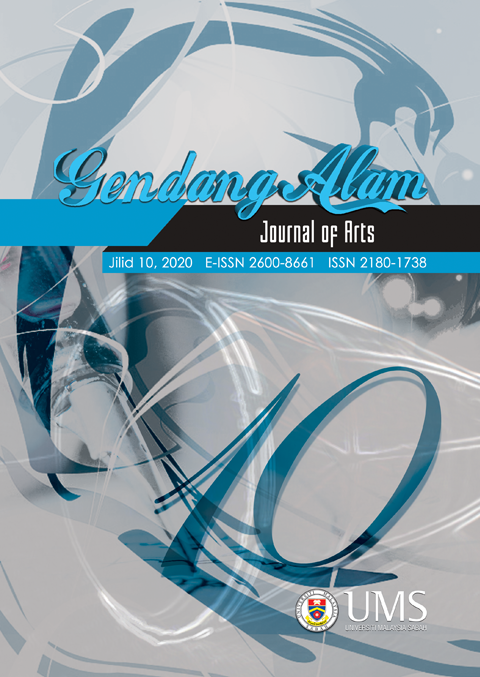SIGNIFIKASI WAU DALAM TELEMOVIE “WAU KASIH”
WAU SIGNIFICATION IN MALAY TELEMOVIE “WAU KASIH”
DOI:
https://doi.org/10.51200/ga.v10i.2584Keywords:
simbol, tanda, filem , wau, falsafah, symbol , signs , films , philosophyAbstract
Wau merupakan sejenis permainan tradisi masyarakat Melayu, terutamanya wau bulan yang menjadi ikon kepada masyarakat Kelantan. Pada masa kini, permainan wau semakin lenyap dek arus globalisasi yang serba canggih, Sedikit sebanyak pemodenan mempengaruhi pola pemikiran masyarakat yang memandang rendah pada hal yang tradisional. Bagi melestarikan permainan tradisi, bidang perfileman dilihat relevan dalam memaparkannya secara visual dan verbal. Kreativiti sutradara atau pengarah dituntut dalam menterjemahkan simbol-simbol budaya sinematik yang memberi makna kepada penonton. Telemovie, Wau Kasih (2016) terbitan Heritages Movie Sdn. Bhd. dengan kerjasama Astro Citra merupakan karya arahan Wan Mohd Rafiq dan pengarah bersama Sabri Yunus, mengisahkan seorang lelaki yang menyara keluarganya dengan mengambil upah sebagai pembuat wau bulan. Makalah adalah hasil penelitian terhadap tanda-tanda dari aspek visual dan verbal dalam telemovie Wau Kasih (2016). Metodologi kajian ini dilaksanakan secara kualitatif. Penulis melakukan pengamatan rapi terhadap video sebagai rujukan utama. Sebagai rujukan tambahan, penulis menjalankan kajian perpustakaan dan rujukan di laman sesawang terpilih untuk menyokong hujahan. Penulis menggunakan kerangka teori semiotik Charles Sanders Pierce yang memberi perhatian terhadap ikon, indeks dan simbol serta semiotik Roland Barthes digunakan sebagai kerangka teori kajian. Melalui pemerhatian yang dijalankan, penulis mendapati ikon wau bulan mempunyai persamaan dengan watak Pak Akob yang berasal dari Kelantan yang kemudiannya berpindah ke Selangor. Wau bulan tersebut juga turut memaparkan indeks utama cerita ini dengan menjelaskan sebab-akibatnya Pak Akob tinggal di negeri orang. Penulis turut mendapati bahawa wau menjadi simbol kepada rona kehidupan seorang individu di muka bumi ini dan terdapat beberapa falsafah kehidupan yang dipaparkan melalui verbal atau pengucapan dialog pelakon. Oleh hal yang demikian, artikel ini diharapkan mampu merapatkan jurang ilmu kajian budaya tradisi dalam industri filem tempatan.
There are various traditional games in the world and one of Malaysia’s iconic traditional games is wau, an intricately designed Malaysian moon-kite. Wau comes in different shapes, sizes and colours. One of the iconic wau is the wau bulan. It is an iconic moon-kite for the Kelantanese in Malaysia. Presently, playing wau seems to be popular due to the globalized advanced technology era which affecting nowadays generation’s mindset and perspective towards traditional games over time. In order to enhance the traditional games in Malaysia, the film industry appear to be appropriate and relevant in promoting the idea, visually and verbally. Translating the cinematic cultural symbols are based on the researchers and author’s creativity as well as delivering the appropriate messages to the audiences. One suitable example of a telemovie called Wau Kasih (2016) from Heritages Movie Sdn. Bhd. and Astro Citra, a masterpiece under Wan Mohd Rafiq collaborating and directing with Sabri Yunus on story-telling about a man supporting his family by working only as a moon-kite maker. Thus, this article focus on the research on visual and verbal aspect in the Wau Kasih (2016) telemovie. This study involved qualitative research methodology. The author studies the telemovie as the main reference for research. The author also utilizes other resources from the library and from the internet in order to support as the literature review for the research. In addition, the author implemented the semiotic theory framework of Roland Barthes and Charles Sanders Pierce’s. On which Charles Sander Pierce’s framework focusing on the icon, index and the symbols. According to the study, the author identifies that the wau bulan’s icon is similar to the character of Pak Akob, a Kelantanese by birth but moved to Selangor ever since. In the story too, it shows that the wau bulan appears to be the main index of the telemovie which explains the transfer of Pak Akob to a foreign country. Moreover, the author also discovered that the wau represents the symbol of a life of an individuals and on top of that, another philosophy of life presented in the telemovie through the actor’s dialogue or script which brings out a deep meaning towards ones’ life. As a conclusion, this research should be able to strengthen and enhance the knowledge of traditional culture research in the local film industries.
Downloads
Published
How to Cite
Issue
Section
License
Submitted manuscripts in the Malay language or English must be original contributions, and have not been previously published or under consideration for publication elsewhere.
Manuskrip dalam bahasa Melayu atau bahasa Inggeris yang diserahkan untuk diterbitkan dalam jurnal ini hendaklah karya asli yang belum pernah diterbitkan, atau yang tidak dihantar untuk pertimbangan oleh mana-mana penerbitan yang lain.






